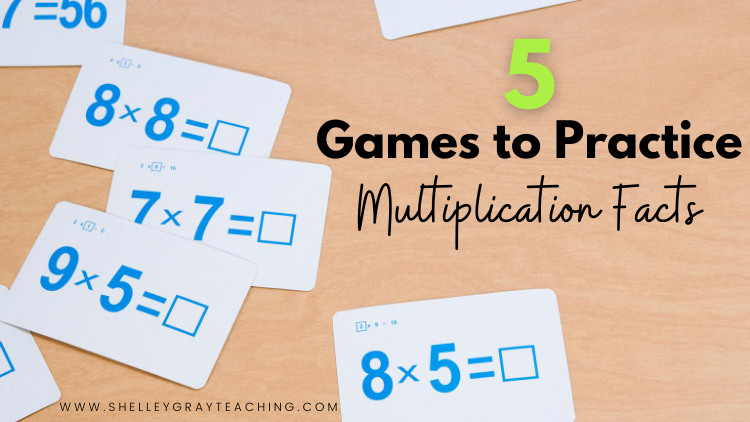
Are you looking for a fun way for your students or children to learn the multiplication facts? Games help reinforce math facts in an interactive, engaging way. Here are five fun games your students can play to reinforce multiplication facts and continue to build their fact fluency.
Table of Contents
Multiplication UNO
Number of Players – 2+ (ideally 3-5 students)
Just as the name suggests, this game is played with similar rules as UNO but with a regular deck of cards and a multiplication twist!
Each student is dealt 7 cards and the remaining cards are placed in the center. The object of the game is to get rid of all the cards you are dealt. In the remaining deck, one card is flipped over to begin play. Whoever can match the same number or suit that is on the first card may play first. After a student plays their card, they must multiply the number on the previous card and the number on the card they are playing. For example, if an 8 of hearts is the first card laid down to begin play, one student could play an 8 of spades, and multiply 8×8.
Each numbered card is worth its own value. Aces mean ‘multiply by 1’ and are a wild card. Kings, Queens, and Jacks mean ‘multiply by 10’ while Kings also mean ‘draw 2,’ Queens are a reversal card, and Jacks are skip-a-turns. Jokers mean ‘multiply by 100’ and are also a wild card + “Draw 4.”
Have students create a key of these card values and meanings to help them remember the rules while the game is still new.
Related: Help Your Students Easily Master the Times Tables With This One Simple Strategy
Multiplication Fact Flip
Number of Players – 2+
This game is an excellent way to practice simple multiplication facts! Begin by removing all of the face cards, Jokers, and Aces so that only the numbered cards 2-10 are left. Next, divide the deck evenly among all players. Choose a target number and write it on a piece of paper nearby or whiteboard. This target number is the number that will be multiplied by each card that students flip.
For example, let’s suppose the target number is 6. Each student will flip over one card from their own personal deck. They will flip a card and multiply that number by 6. Whoever has the largest product takes all the cards. If a player says the wrong product, the other player can make the correction and take the cards.
You could easily set a round limit on this game and whoever has the most cards after a specific number of rounds, wins. Or the game can end when one player runs out of cards.
Spiral Multiplication
Number of Players – 2+
Spiral multiplication does require at least one or two dice (depending on-level of difficulty) as well as individual game pieces in addition to your deck of cards. If you don’t have game pieces, you can easily use colored pencil top erasers or even crayons. If you are looking for a virtual dice option, here is a good one to use.
Have students create their own spiral game board with their deck of cards. They may create the game board in any shape or style similar to a Candyland format or even just a simple Monopoly style that repeats around. Students place their game pieces at whatever card is established as “start.” The first player rolls the die and multiplies the number on the die by whatever number the “start” card is. If the student gets the answer correct, he moves the number of spaces that are shown on the die. For example, if the “start” card is a 5 and the first player rolls a 3, he must answer 15 and then move 3 spaces around the board.
Students will love creating their own game board set-up and it is the perfect opportunity to practice facts!
Zone
Number of Players – 2+
Zone is a strategic game where students have to find two cards with a product that is in the “zone.”
First, each player is dealt 10 cards. The remaining cards are piled in the center. Aces are worth 11, Jacks are 12, Queens are 13, and Kings are 14. The first card in the center deck is flipped over and that number is multiplied by 10. Each player looks at their own decks to find two numbers that are in the same “zone.”
For example, suppose the card that is flipped is a 4. It is multiplied by 10, creating a product of 40. The product zone is now 40-49. Students must look at their own decks to find two cards whose product is in the zone of 40-49. If a player has 2 cards that can be multiplied to create a product in that zone, they can remove those cards from their deck. Whoever runs out of cards first, wins!
Mind Reader (also known as Salute)
Number of Players – 3
Mind Reader specifically requires three players so that one player can act as the “leader” and the other two players are the mind readers. Remove all face cards, Jokers, and Aces and then split the deck in half. The two students playing as the mind readers each take half of the deck.
The mind readers take 1 card off the top of their deck and hold it next to their forehead for everyone else to see except for themselves. Because the leader can see both cards, she multiplies the numbers and says the product out loud. The mind readers must decide what number they are holding, based on knowing the product and the other mind reader’s card.
For example, suppose that the leader says, “42.” If one mind reader can see that the other mind reader is holding a 6, she knows that her card has to be a 7. Have students rotate duties so that each one is able to play the leader, as well as mind readers!







One Comment
These look great! Thanks for sharing!